The good news is that technology from the high-end professional DSLRs has over time trickled down to more affordable compact cameras - technologies such as image stabilization, high speed continuous shooting modes and minimal shutter lag operation. These 3 features in particular can play a major role in ensuring you get the shot you're after. Image stabilization helps ensure your photo is crisper, sharper by compensating for any camera shake if it's freezing cold and you can't quite keep that camera perfectly still in a buffeting wind. High speed continuous shooting, which allows you to take upwards of 3-4 shots per second, helps ensure you capture that fleeting moment. It's especially helpful when taking action shots where the subject is fast moving or a little unpredictable. For the same reason minimal shutter lag is also handy - it allows you to capture the exact composition you're expecting, not what follows half a second later!
So, what else to look for?
Well, try and find a camera that has a zoom that allows for wide angle shots - at least 28mm, better yet 24mm. A wide angle is vital for landscapes and group shots taking in a wider view of the surroundings. Free software available online from all the major players such as Nikon, Canon, HP and Olympus can be used to stitch together images and create great panoramic shots. Just make sure to allow for a little overlap between each image so the software can create a composite image. A wide angle on your zoom range also great for self-portraits of yourself one-handed.
Low weight. An absolute necessity. Lean, compact cameras are are a must! If it's too bulky or heavy you'll find yourself leaving it back at base or cursing every time you have to claw it out from a pack because it's simply to big to slip into a jacket pocket. Your camera needs to be available so that you can capture those spontaneous moments that will remind you of the fun times in the mountains. Just as important, a slimline camera ensures you aren't wasting time pulling out and stashing away your piece of kit overtime you want to capture an image - which, over time, can waste precious time on a route. Look for a compact camera under 200gm in weight.
A "fast lens". The speed of a lens refers to the maximum size of its aperture. In a compact camera an aperture of f2.8 is considered fast, and f1.8 very fast. Why does this matter? Well, a fast wide aperture allows for better photography when you're dealing with low light conditions - early morning alpine starts or atmospheric shots at dusk. If the weather's bad and you've little sunlight a fast aperture will allow more room for manouevre when shooting any action shots too - the wider aperture means you can shoot at higher speeds, lessening the chance of a blurred subject in the final photo.
Five 'Tough Compact' cameras reviewed
'Tough cameras' - exactly what it says on the tin! A little bit more rugged in design to ensure they can handle a few more knocks and scrapes. Most are also water resistant to several metres. They are not, however, indestructible! Dropped 60ft down a crag, or have a snowcat drive over it and it's unlikely to survive! That said, they are more durable, which is a definite bonus - freeing up time and energy from worrying about a delicate piece of kit getting damaged and having to pack it away in bulky padded cases that are often awkward to access.
Olympus TG-310
The TG-310 is waterproof to 3 metres, shockproof from heights of up to 1.5m, and freezeproof to -10°C. 14 megapixel image sensor and a 3.6x wide optical zoom (28-102mm equivalent). Dual Image Stabilisation for reducing blur with fast-moving shots. In-camera panorama function to easily capture spectacular wide-screen views of a landscape or city scene.
Weight: 155gm including battery and memory card.
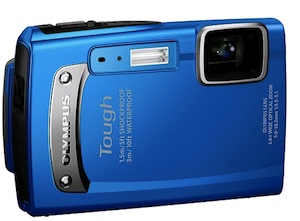 |
Pros:
Super lightweight. Simple uncluttered
Cons:
Poor LCD monitor. Buttons are rather fiddly and on the small side. Some issues with image quality.
|
Fujifilm XP50
The FinePix XP50 is durable and waterproof to a depth of 5m and can capture both movies and still images. The camera's casing will withstand shocks or drops from a height of 1.5 m while cold environments are also no problem for this hardwearing device. The FinePix XP50 can withstand temperatures down to −10°C and dust is brushed aside with all the camera's access points specially sealed for ultimate protection. The FinePix XP50 boasts a 14 mega-pixel CMOS sensor and a new image processor. ISO sensitivity up to 3200 and CMOS Shift Image Stabilization helps ensure that shots remain crisp and sharply focused, even when capturing pictures in low-light environments. The FinePix XP50 also has a micro HDMI output to connect the camera to an HDTV to see both images and movie in High Definition.
Weight: 175gm including battery and memory card.
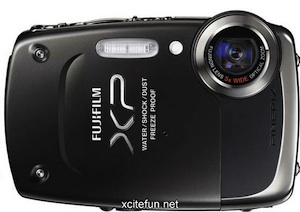 |
Pros:
Low cost
Cons:
Picture quality not up to the same standard as the Pentax or Olympus. On the heavy side.
|
Panasonic Lumix DMC-TS3
he DMC-TS3(FT3) is shockproof, waterproof, dustproof and freezeproof in design with the capability to record high-definition movie in AVCHD format. Featuring a 28mm wide-angle lens, the iA (Intelligent Auto) Mode and GPS function, this versatile camera lets you capture your moments no matter what the intended shooting terrain is. The LUMIX DMC-TS3 is specifically designed for active users who want to capture high-quality photos and 1920 x 1080 full-High Definition videos, incorporating a powerful rugged design and outdoor-friendly features, such as a built-in GPS function, a compass, altimeter and barometer. The 12.1-megapixel LUMIX TS3 further strengthens its toughness, when compared to its LUMIX TS2 predecessor, and is now waterproof to approximately 40 feet (12m); shockproof to approximately 6.6 feet (2m); freezeproof to -10 degrees C; and dustproof.
Weight: 197gm including battery and memory card.
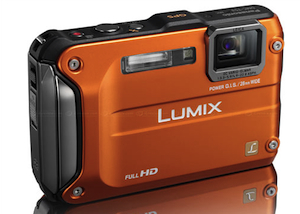 |
Pros:
Ease-of-use, bombproof construction. Good battery life.
Cons:
Image quality not quite as good as its competitors. Higher price. |
Nikon Coolpix AW100
Waterproof to depths of 10m, shockproof from heights of up to 1.5 m and freeze-proof for temperatures down to -10°C. 16 megapixel back illuminated CMOS image sensor: increases the amount of light that each pixel receives, improving sensitivity and reducing noise for superb performance in any light. Anti-blur technology automatically counters blurred images in four different ways. Hybrid VR (Lens-shift and Electronic Vibration Reduction) reduces the effect of camera shake. High ISO (up to 3200) light sensitivity reduces the risk of blurred images with fast-moving subjects or in low light. The built-in GPS system, electronic compass and world map allows geo-tagging of your images.
Weight: 178gm including battery and memory card.
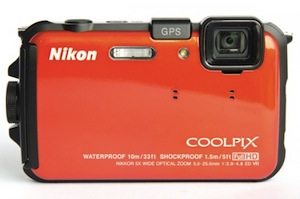 |
Pros:
Solid build.
Cons:
Controls a little fiddly. Not the best for image quality. Price on the high side. |
Pentax Optio WG1
The new Optio WG1 has great shockproof and crush proof capabilities, which enable it to withstand a freefall from 1.5 meters high and the pressure of a weight of up to 100 Kg. Equipped with a 14 megapixel CCD sensor and a wide-angle 5x optical zoom (equivalent to a 28mm – 140mm in 35mm) the camera also features a 1cm macro function. The Optio WG1 can also endure extreme temperatures as it is cold proof up to -10°C. The Optio WG1 is also waterproof up to 10 metres.
Weight: 165gm including battery and memory card.
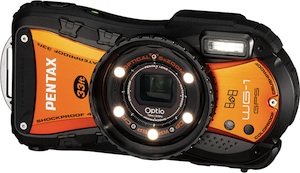 |
Pros:
The most robust of all the cameras reviewed. Waterproof to 10 metres. Low weight. Good value for money.
Cons:
Fiddly zoom controls. Looks - not everyone's cup of tea! |
Other top tips for your camera kit
1. If possible take a spare battery. These days batteries for compacts are extremely lightweight at around 17-20gm. Carry a spare battery in your pocket where it will stay warm.
2. Consider carrying a spare memory card. You might find yourself using up all the space on your camera's card and needing extra storage space - what next? Spending time deleting unwanted shots is too time consuming and is guaranteed to drive your party crazy. Worse still is having a corrupted memory card that just won't function however many times your select 're-format' on your camera. Having a spare card (at around £5 for a 4GB card) and just 2 grams in weight is the smart option!
3. Choose one of the brighter coloured camera models. Cameras are always getting left places… nothing worse than realizing you left your camera on the summit when you get back down and want to share with everyone your latest achievement! You'd be surprised how easily a small grey and black compact blends in with the scenery. Yes, bright orange cameras are a bit garish, but they're easier to find when dropped, and less likely to get lost or left behind.
Other top tips for your camera kit
 Off-Piste
Off-Piste Ski Touring
Ski Touring Via Ferrata
Via Ferrata Ice Climbing
Ice Climbing Alpine Glacier Trekking
Alpine Glacier Trekking Worldwide Trekking
Worldwide Trekking



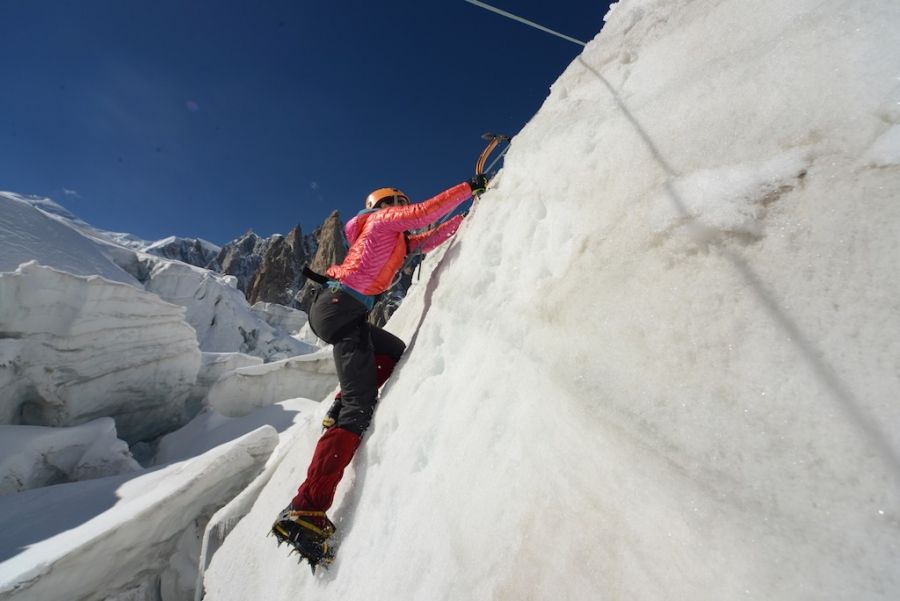





 Travel Website Development
Travel Website Development